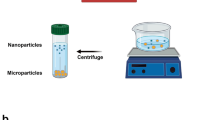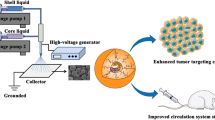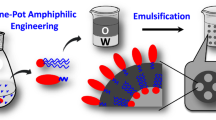Abstract
The aim of the study was to develop ultrathin polyelectrolyte microreservoir (UPM) using two combinations of synthetic/synthetic (S/s; poly(allylamine hydrochloride) (PAH)/sodium poly(styrenesulfonate)) and synthetic/natural (S/n; PAH/sodium alginate) polyelectrolytes over spherical porous CaCO3 core particles (CP) followed by core removal and to evaluate its biocompatibility and integrity of loaded model protein bovine serum albumin (BSA). A novel process for synthesis of CP was developed to obtain maximum yield of monodisperse vaterite (spherical) polymorph. The prepared UPM was characterized for surface morphology, layer-by-layer growth, pay load efficiency, integrity of BSA, as well as viability and cell adhesion using murine J 774 macrophages (Φ). In vitro release profile revealed that both S/s and S/n UPM were able to provide sufficient diffusion barrier to release protein at physiological pH. It has been observed that S/n UPM are fully biocompatible due to obvious reason of using natural polymer. In a separate experiment, the S/s UPM surface was modified with pluronic F-68 to tune biocompatibility which provides evidences for safety and tolerability of the S/s UPM as well. In nutshell, the proposed system could successfully be used for the delivery of proteins, and moreover, the system can be tailored to impart desired properties at any stage of layering especially in terms of drug release and to retain the integrity of proteins.











Similar content being viewed by others
References
Gao CY, Donath E, Mohwald H, Shen JC. Spontaneous deposition of water-soluble substances into microcapsules: phenomenon, mechanism and application. Angew Chem Int Ed. 2002;41:3789–93.
Sukhorukov GB, Donath E, Moya S, Susha A, Voigt A, Hartmann J, et al. Microencapsulation by means of step-wise adsorption of polyelectrolytes. J Microencapsul. 2000;17:177–85.
Lvov Y, Antipov AA, Mamedov A, Mohwald H. Urease encapsulation in nanoorganized microshells. Nano Lett. 2001;1:125–8.
Dahne L, Leporatti S, Donath E, Mohwald H. Fabrication of micro reaction cages with tailored properties. J Am Chem Soc. 2001;123:5431–6.
Sukhorukov G. Designed nano-engineered polymer films on colloidal particles and capsules. In: Mobius D, Miller R, editors. Novel methods to study interfacial layers. Amsterdam: Elsevier Science; 2001. p. 383–414.
Decher G, Hong JD, Schimtt J. Buildup of ultrathin multilayer films by a self-assembly process: III. Consecutively alternating adsorption of anionic and cationic polyelectrolytes on charged surfaces. Thin Solid Films. 1992;210(1–2):831–5.
Volodkin DV, Petrov AI, Prevot M, Sukhorukov GB. Matrix polyelectrolyte microcapsules: new system for macromolecule encapsulation. Langmuir. 2004;20(8):3398–406.
Shchukin DG, Patel AA, Sukhorukov GB, Lvov YM. Nanoassembly of biodegradable microcapsules for DNA encasing. J Am Chem Soc. 2004;126:3374–5.
Pommersheim R, Schrezenmeir J, Voigt W. Immobilization of enzymes by multilayer microcapsules. Macromol Chem Phys. 1994;195:1557–67.
Gombotz WR, Wee SF. Protein release from alginate matrices. Adv Drug Deliv Rev. 1998;31:267–85.
Singh ON, Burgess DJ. Characterization of albumin–alginic acid complex coacervation. J Pharm Pharmacol. 1989;41:670–3.
Ku C, Dixit V, Shaw W, Gitnick G. In vitro slow release profile of endothelial cell growth factor immobilized within calcium alginate microbeads. Artif Cells Blood Substit Immobil Biotechnol. 1995;23:143–51.
Vandenberg GW, De La Noue JJ. Evaluation of protein release from chitosan–alginate microcapsules produced using external or internal gelation. J Microencapsul. 2001;18:433–41.
Dupuy B, Minnot AP. FT-IR of membranes made with alginate/polylysine complexes—variations with the mannuronic or guluronic content of the polysaccharides. Artif Cells Blood Substit Immobil Biotechnol. 1994;22:71–82.
Martisen A, Skjak-Braek G, Smidsrod O. Alginate as immobilization material: I. Correlation between chemical and physical properties of alginate gel beads. Biotechnol Bioeng. 1989;33:79–89.
Sukhorukov GB, Mohwald H. Multifunctional cargo systems for biotechnology. Trends Biotechnol. 2007;25(3):93–8.
Zahr AS, De Villiers M, Pishko MV. Encapsulation of drug nanoparticles in self-assembled macromolecular nanoshells. Langmuir. 2005;21:403–10.
Khopade AJ, Caruso F. Surface modification of polyelectrolyte multilayered-coated particles for biological application. Langmuir. 2003;19:6219–25.
Smith PK, Krohn RI, Hermanson GT, Mallia AK, Gartner FH, Provenzano MD, et al. Measurement of protein using bicinchoninic acid. Anal Biochem. 1985;150:76–85.
Hansen MB, Nielsen SE, Berg K. Re-examination and further development of a precise and rapid dye method for measuring cell growth/cell kill. J Immunol Meth. 1989;119:203–10.
Decher G. Fuzzy nanoassemblies: towards layered polymeric multicomposite. Science. 1997;277:1232–7.
Laemmli UK. Cleavage of structural proteins during the assembly of bacteriophage T4. Nature. 1970;277:680–5.
Caruso F, Caruso RA, Mohwald H. Nanoengineering of inorganic and hybrid hollow spheres by colloidal templating. Science. 1998;282:1111–4.
Ye S, Wang C, Liu X, Tong Z. Deposition temperature effect on release rate of indomethacin microcrystals from microcapsules of layer-by-layer assembled chitosan to alginate multilayer films. J Control Release. 2005;106:319–28.
Donath E, Moya S, Neu B, Sukhorukov GB, Georgieva R, Voigt A, et al. Hollow polymer shells from biological templates: fabrication to potential applications. Chem Eur J. 2002;8:5481–5.
An ZH, Lu G, Mohwald H, Li JB. Self assembly of human serum albumin and L-alpha-dimyristoylphosphatidic acid (DMPA) microcapsules for controlled drug release. Chem Eur J. 2004;10:5848–52.
Hoogeveen NG, Stuart MAC, Fleer GJ, Boher MR. Formation and stability of multilayers of polyelectrolytes. Langmuir. 1996;12:3675–81.
Dubas ST, Schlenoff JB. Polyelectrolyte multilayers containing a weak polyacid: construction and deconstruction. Macromolecules. 2001;34:3736–40.
Antipov AA, Shchukin L, Fedutik Y, Petrov AI, Sukhorukov GB, Mohwald H, et al. Carbonate microparticles for hollow polyelectrolyte capsules fabrication. Colloids Surf, A Physicochem Eng Asp. 2003;224:175–83.
Winger TM, Ludovice PJ, Chaikof EL. Formation and stability of complex membrane-mimetic monolayers on solid supports. Langmuir. 1999;15:3866–74.
Lee JW, Park JK, Lee JH. Thermo sensitive permeation from side-chain crystalline ionomers. J Polym Sci, B, Polym Phys. 2000;38:823–30.
Yan C, Resau JH, Heweston J, West M, Rill WL, Kende M, et al. Characterization and morphological analysis of protein loaded poly (lactide-co-glycolide) microparticles prepared by water-in-oil-in-water emulsion technique. J Control Release. 1994;32:231–41.
Gander B, Thomasin C, Merkle HP, Men Y, Corradin G. Pulsed tetanus toxoids release from PLA-microspheres to its relevance for immunogenicity in mice. Proc Int Symp Control Release Bioact Mater. 1993;20:65–6.
Schwendeman SP, Costantino HR, Gupta RK, Tobio M, Chang AC, Alonso MJ, et al. Strategies for stabilizing tetanus toxoid towards the development of a single-dose tetanus vaccine. In: Brown F, editor. New approaches to stabilization of vaccines potency. Dev Biol Stand, 57. Basel: Karger; 1996. p. 293–306.
Tabata Y, Ikada Y. Effect of size and surface charge of polymer microspheres on their phagocytosis by macrophage. Biomaterials. 1988;9:356–62.
Torche AM, Corre L, Albina P, Jestin EA, Verge R. PLGA microspheres phagocytosis by pig alveolar macrophages: influence of poly (vinyl alcohol) concentration, nature of loaded-protein and copolymer nature. J Drug Target. 2000;7:343–54.
Muller RH, Ruhl D, Paulke BR. Influence of fluorescent labeling of polystyrene particles on phagocytic uptake surface hydrophobicity and plasma protein adsorption. Pharm Res. 1997;14:18–24.
McEvoy L, Williamson P, Schlegel RA. Membrane phospholipid asymmetry as a determinant of erythrocyte recognition by macrophages. Proc Natl Acad Sci USA. 1986;83:3311–5.
Acknowledgments
Financial assistance to Dr. P.R. Mishra through CSIR XI Network project (NWP 0035) on “Nanomaterials and Nanodevices for applications in Health and diseases” is gratefully acknowledged. Girish K Gupta and V. Jain are thankful to Indian Council of Medical Research and Council of Scientific and Industrial Research, New-Delhi, India for providing Senior Research Fellowships and Research Associate fellowship, respectively. Prof. S.C. Lakhotia, Department of Zoology, Banaras Hindu University, Varanasi, India is gratefully acknowledged for providing Confocal Laser Scanning Microphotography facility. The CDRI communication no. is 7409.
Author information
Authors and Affiliations
Corresponding author
Rights and permissions
About this article
Cite this article
Gupta, G.K., Jain, V. & Mishra, P.R. Templated Ultrathin Polyelectrolyte Microreservoir for Delivery of Bovine Serum Albumin: Fabrication and Performance Evaluation. AAPS PharmSciTech 12, 344–353 (2011). https://doi.org/10.1208/s12249-011-9593-2
Received:
Accepted:
Published:
Issue Date:
DOI: https://doi.org/10.1208/s12249-011-9593-2




